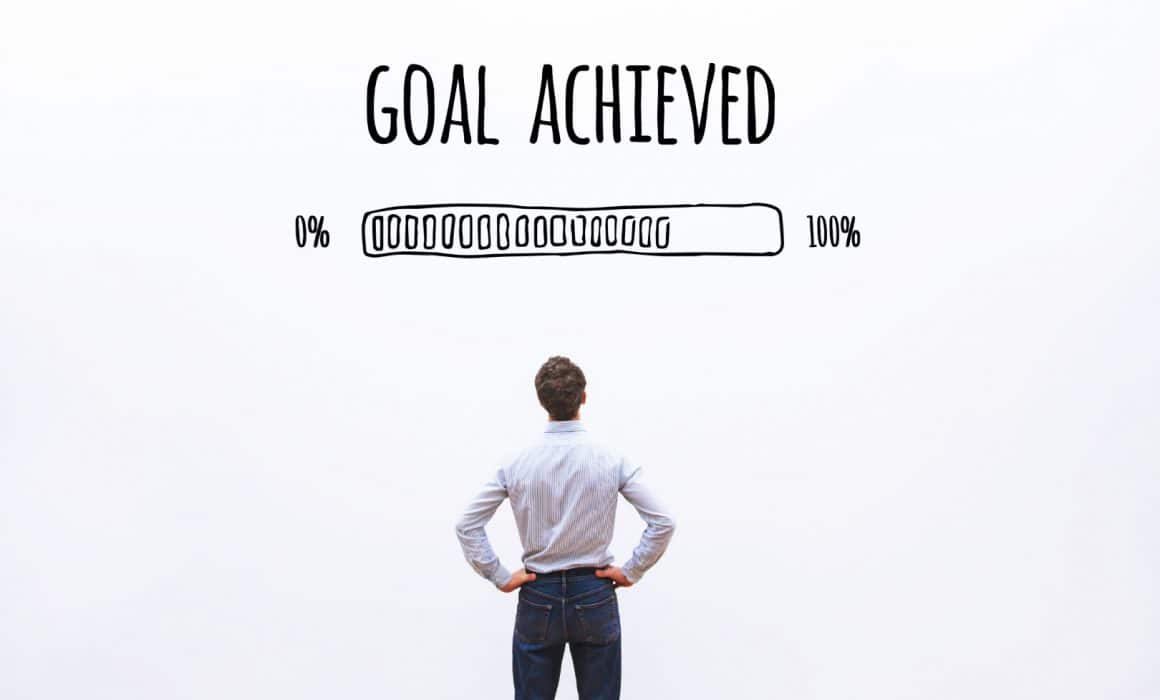Motivating Revenue-Generating Habits in Sales Teams with Gamification
Strengthen your team performance with sales gamification
Who hasn’t felt burnt out at one point or another? We know that unclear goals, poor focus or dull incentives can lead to apathy. And that hurts your team’s performance. To stave off this motivational dip, companies can use engagement techniques bolstered by gamification.
You probably know sales gamification is a thing, but perhaps not how to apply it effectively. But sales gamification motivates sales reps to adopt revenue-generating habits and combats apathy. So, it’s worth diving in to.
Initially, we’ll review what sales gamification is. And we’ll explore how it improves productivity, what it can do for incentives and some practical applications.
Lastly, we’ll give you an overview of different sales gamification tools too. These include coupons, points, progress bars and more. You’ll walk away from this article with a deep understanding of how gamification can help your sales team.
Table of Contents
- Strengthen your team performance with sales gamification
- What is sales gamification?
- How does sales gamification improve employee performance and productivity?
- The role of gamification in sales incentive programs
- Main sales gamification elements and features for sales teams
- Conclusion
- Machine Learning In Finance: 12 Essential Applications
- How To Create Interactive Compliance Training For Bank Employees
- How Fintech Apps Are Using Gamification To Increase User Engagement
- Top Gamification Companies for Employee & Customer Engagement
Download your free
“Gamification Guide”
Get your PDF now and start transforming your approach to digital engagement!
What is sales gamification?
Essentially, sales gamification creates a link between healthy competition and business targets. The human brain loves to win. And sales gamification turns big tasks into small ones that your team can achieve and learn easily. This is much less stressful on your team and provides them with dopamine hits throughout the day.
First, tech makes it easy to create gamification everyone wants to participate in. Next, it provides visibility to everyone on your team. Last, achievement triggers instant rewards and that dopamine rush. Above all, these strategies are powerful because they change behaviours. They can teach and instruct. And that’s in combination with positive feedback that humans crave.

How does it work? Well, games tap into an ancient and intuitive reward system. As each level is achieved, the brain looks for that next dopamine release. So, it’s a self-motivating system. Sales Gamification can also make dull topics fun!
Think of the most tedious process in your organization. What if it was chopped into bite-sized pieces and tied to rewards and rankings? More tolerable, right? Overall, when your team is having fun while achieving targets, burnout is further afield.
So, sales gamification lets your team learn revenue generating habits through progressive achievement. And that’s good for your bottom line.
How does sales gamification improve employee performance and productivity?
Well, let’s start with the science behind positive reinforcement. According to Simply Psychology, “Positive reinforcement is a term described by B. F. Skinner in his theory of operant conditioning. In positive reinforcement, a response or behavior is strengthened by rewards, leading to the repetition of desired behaviour. The reward is a reinforcing stimulus.” So, at its core, we like rewards because our brains are wired to.
You’ve seen this every time you’ve given out sales bonuses or trained a dog with treats. Rewards are powerful. Now sales gamification uses the principles of positive reinforcement to set achievable milestones and give incremental rewards.
In this article, we selected the best ideas to reward employees:

Above all, you’re creating positive habits (for your company and your team). And there are knock-on benefits too. Positive reinforcement can increase retention, highlight progress, boost loyalty, lure talent, improve customer service and reward successes. Management also gets access to great data. And that can lead to a culture of data-driven decision-making.
The role of gamification in sales incentive programs
You know you want to drive sales. That’s a given. But sales gamification can also strengthen your team by offering learning opportunities. Management can use the wealth of data to coach poor performers.
And overall, no one feels like they’re left behind. That’s great for retention and morale. You’ll soon see big gains in your overall employee engagement.
1. Incorporate gamification with CRM solutions
Gamification works well with CRM solutions. There’s always some resistance to new tech in sales operations. Agents logging sales notes often feel it’s a waste of time. And it’s easy to see why. When there’s no reward for keeping good notes, there’s no incentive.
But when there’s a milestone reward for completing these tasks, it’s more fun. As a result, managers have more data to hand. They can make better decisions and forecasts. Plus, they know whom to target for coaching. It’s a win-win!

Bring everyone into the fold with sales gamification. When employees are encouraged to meet reporting requirements, log client interactions and complete daily tasks through gamification; it gets done. You might say, “I pay them, that’s enough.”
But you’re missing out on that positive reinforcement that our brains really respond to! Plus, there are so many other motivators like storytelling, freedom, responsibility, social status, emotions and values.
So, equip your CRM with scores, leaderboards, rewards and penalties. Drive the action you want with healthy competition. Make boring tasks into levels to beat. Adoption is swift and automatic. Especially when the benefit is easily understood. (I do X, I get Y.)
And there are great benefits for sales managers too
- New employees are onboarded quicker.
- Team and individual performance are rewarded and recognised.
- Poor performance is penalised through low scores.
- Badges provide interim rewards in place of monetary ones.
- Employees are driven to win, not just meet targets.
- Managers get great data they can use for coaching.
- Corporate goals are aligned natively with an employee’s personal goals.
Now, to do this implementation well, gamification for CRM systems must:
- Help your team make good decisions and prioritise tasks to KPIs.
- Combine a mix of team and individual goals.
- Break the processes down to achievable goals.
- Include orientation modules that get new starters up to speed quickly.
- Roll out with a full education piece for total imbedding.
Gamification needn’t be restricted to the sales floor either. In fact, when started during orientation, it can help your team get up to speed with the approach.
They’ll become comfortable with the technology. And they’ll emerge from onboarding with a goal-focused approach. We’ll explore that further in the next segment.
2. Build fluent product knowledge with gamification integrated with LMS
It will come as no surprise that two thirds of employees find training boring. That’s a shame. Chances are you’ve made L&D a big part of your organisation. And to find that it might not be working? Crushing.
But there are things you can do. Make your learning management system (LMS) more engaging. You really NEED to if you’re going to see any positive returns from your investment. It might sound intuitive, but your team should enjoy using the LMS.
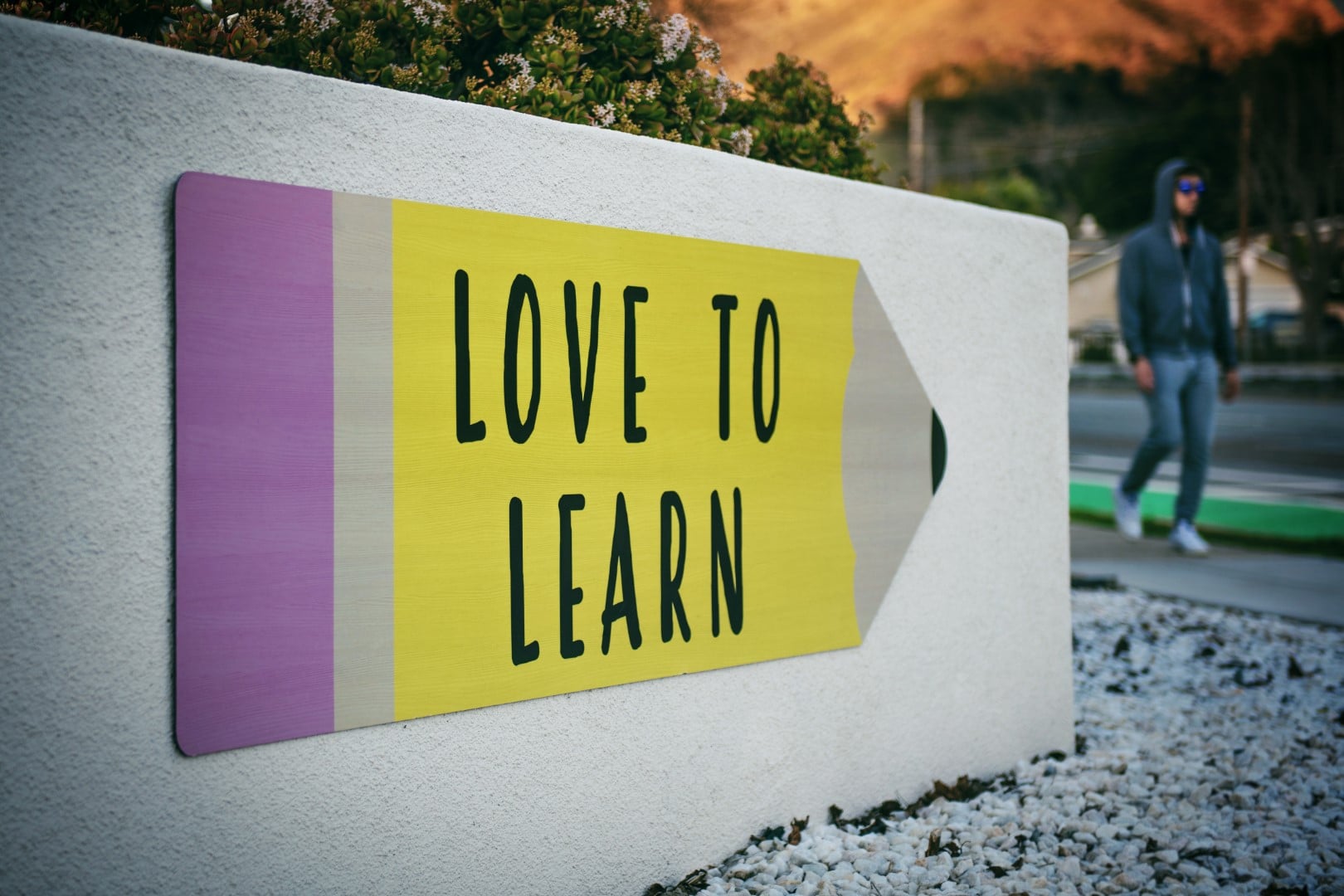
If they’re not interested, you won’t foster adoption.
Sales gamification can help here to drive that uptake. Assign tasks and challenges just like they’re out on the sales floor. It’s good for engagement and great training for the real thing too.
Plus, they’ll remember more of the content too. If we don’t want half of the material forgotten with an hour, we need to make it interesting. Present it in a way that aids recall. When we’re completing, an old part of our brain is triggered.
So, pepper in leaderboards, content, scores and badges to keep learners engaged. You want to attach happy chemicals to the material for longer-term retention.
Lastly, you’ll also reinforce a culture of learning. And that’s a great thing for employee morale. When learning is fun and the LMS is working to reinforce that fun, great things happen. Your team will take pride in that they’ve learned and those accomplishments everyone can see. When you make a link between learning, fun and retention; you’ve nailed LMS gamification.
3. Run sales contests and display leaderboards on tv
Is it really a win if no one is around to see it? It’s the proverbial tree falling in the woods. That’s why sales contests with visible leaderboards are so effective. When everyone can see their position on prominent TV screens, there’s accountability.

No one is a shrinking violet. Managers can tap into these heightened emotions to verbally encourage team performance.
It creates a healthy buzz on the sales floor that’s contagious. Lastly, effective sales contests drive desired business performance at their core. You’re creating a connection between healthy competition, positive reinforcement and sales performance. Just perfect. When used sparingly to achieve specific goals, they’re highly engaging sales gamification tools.
4. Set objectives to sales teams within a gamified app
But who doesn’t love individual targets too? Visible leaderboards are powerful, but for the best results combine them with individual contributions too. A gamified app works great for this. Ideal for desktops or mobile phones, apps are accessible and convenient tools.
Sales agents can view their progress against objectives you set for them. (Obviously, these objectives should align with KPIs.)

Above all, you want to motivate high-performing behaviours.
So, a quick-to-access app is a great way to do this. Award badges, high scores and other rewards for model behaviours. Let sales stars coach those who may be struggling. And set whole teams towards a stretch goal for collaborative competition.
Main sales gamification elements and features for sales teams
1. Contests and Leaderboards
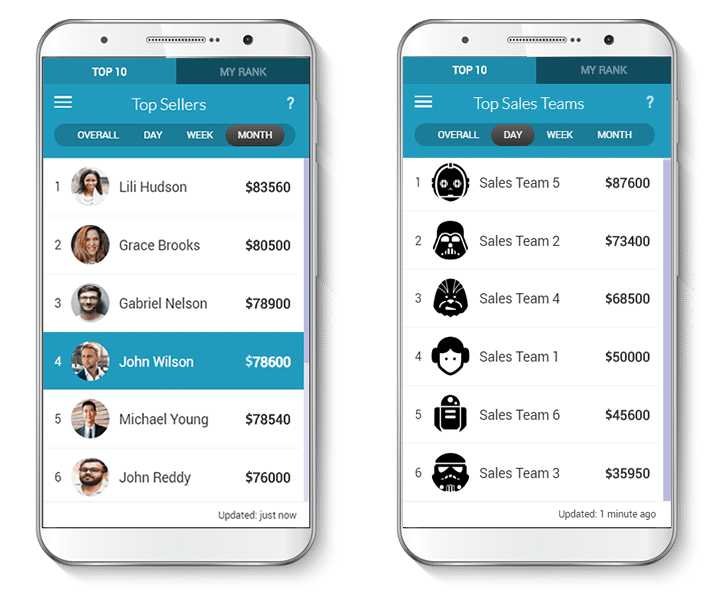
Humans love transparency. It’s refreshing to know where you stand. That’s why contests and leaderboards are so effective for sales team gamification. Simply assign goals that align with your KPIs and let human nature take the reins.
Showing results in real-time on big displays add gravitas to these targets. Remember to include personal and team targets for best results. Not only will you achieve your business goals, but you’ll also:
- Track team and individual performance in real time against key metrics.
- Make better data-driven decisions.
- Drive healthy competition within the sales team for peak performance.
- Double down on a transparent work culture.
Download your free
“108 Gamification Elements and Mechanics”
Get your cheat sheet and have a quick reference at your fingertips!
2. Campaigns and challenges
When you have a big target to hit, give it some gravitas. Building seasonal campaigns can help motivate a flurry of sales activity. Campaigns should drive stretch behaviour and consist of layered challenges.
Each challenge should add incremental progress to your sales team’s personal and team achievements. Vary the rewards for each level. For example, you might have badge rewards for smaller targets and financial incentives for challenging goals. Themes and branding can help to make campaigns stickier.
If there’s no chance to get these limited time badges in the future, it makes them more desirable. So, consider the principle of scarcity here.
3. Badges
Motivation is a function of the mind. If we don’t want to do something, it’s hard to summon the energy. Plus, there’s often no reward for doing tedious tasks. You’re not going to get a sticker for taking out the rubbish or filing your taxes.
Maybe that’s why many people put it off. But you can fix this within your sales team. Badges give little shiny rewards for progress. They’re especially effective on ‘boring’ tasks. In fact, many triple A game titles use badges in their video games. Consider implementing them for newly acquired skills to drive retention.
Or perhaps, assign some badges to your sales target levels. Each little sign of appreciation keeps your sales team more motivated to achieve the next level
4. Points and levels system
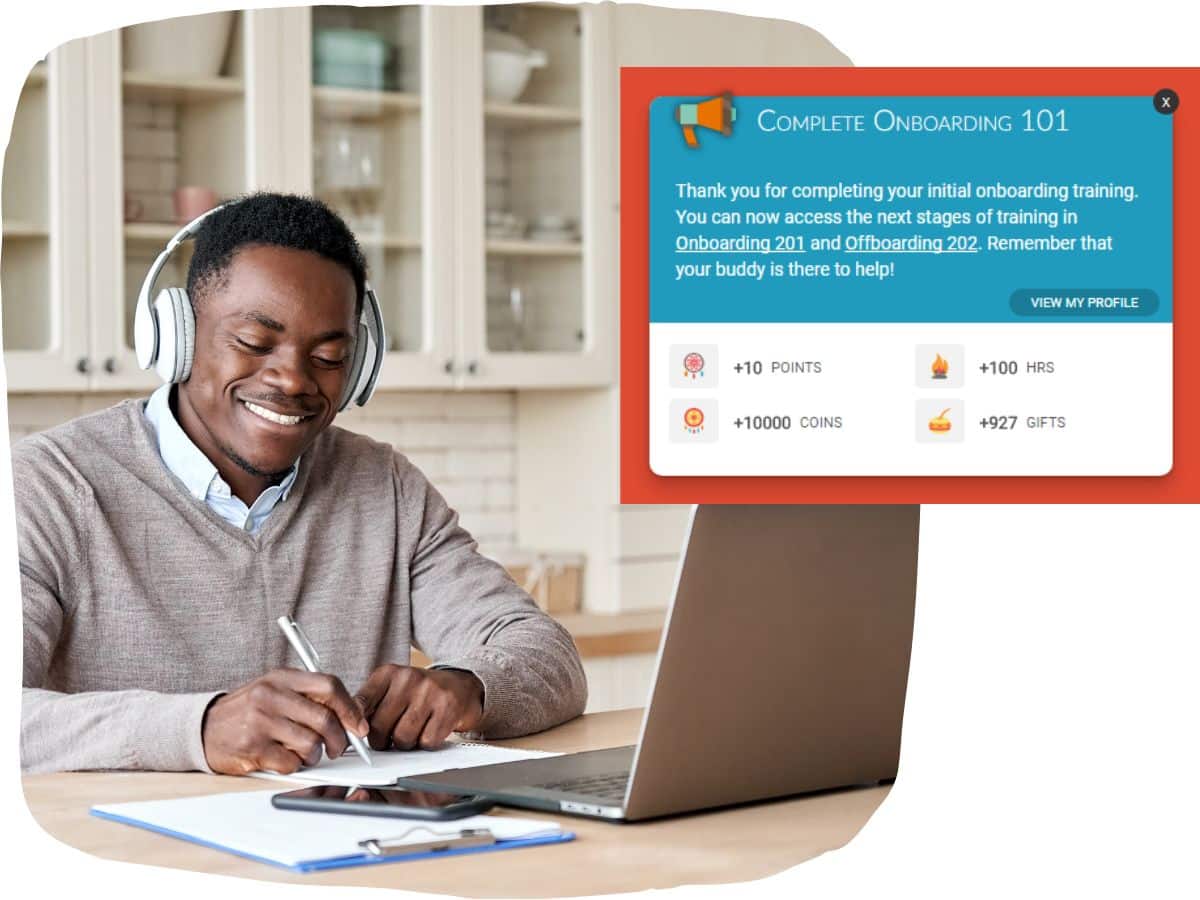
Points and levels are the basis of most games (inside the workplace and out). They are a very visible reminder of seniority, success and authority. And that’s pretty motivating for sales teams on its own. But there’s more to them. Points and levels can help managers rank their reps.
Sales Development Reps (SDRs) need to be scored. Otherwise, how can managers identity strong and weak performers. But sales gamification can add some transparency across the team.
No one is accused of favouritism when the ranks are clear to see. And that’s great for employee loyalty and retention. Points and levels should be applied to both personal and team scores, however.
5. Coupons and rewards

Reserve coupons and rewards for your biggest targets. Badges, points and levels exist to drive that base-level activity. But good sales gamification takes it one step further. When you have a huge stretch target to hit, you may need to mix in physical rewards and coupons.
Above all, these tap into employees with high financial reward motivations. So, use them sparingly and when they’ll really count towards business goals. Think outside of the box too. You need not give cash.
Discounts for local lunch spots, extra holidays and other soft rewards are just as motivating. Remember to include team and individual milestones when driving targets up.
6. Progress bar
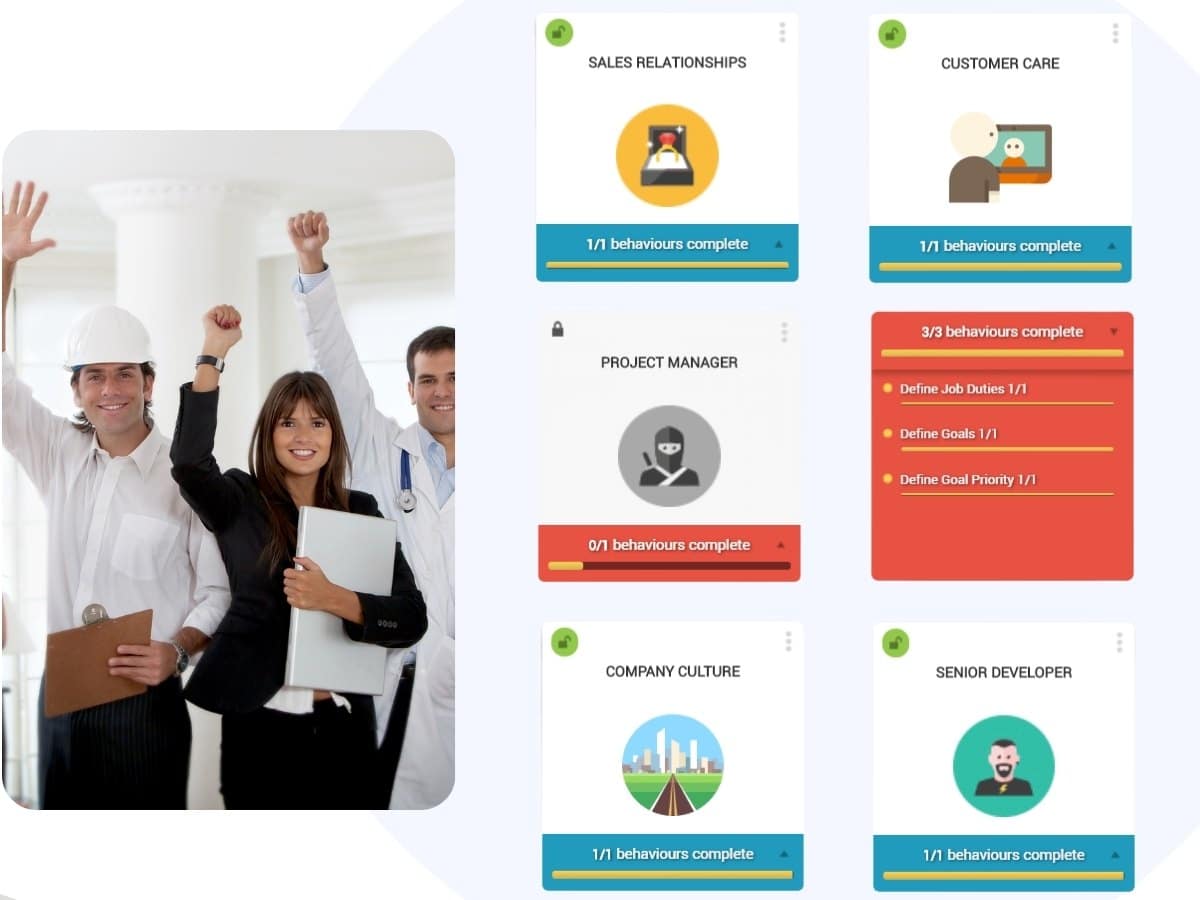
Seeing process is powerful.
According to the BBC, “…in restaurants where customers can see chefs working in the kitchen. Diners rated the quality of food from those restaurants as 22% higher than the same food when they could not see it being prepared.”
Seeing a progress bar reminds us that we’ve achieved something already. It helps us to visualise the finish line. And we all need that to stay motivated during a task. Ever been writing a report and found yourself constantly checking the word count? You needed that reinforcement that you’re making progress.
It’s the same with sales gamification. A progress bar helps maintain the energy needed to finish a started task.
Conclusion
Sales gamification isn’t a mysterious thing. It’s based on science and backed by a lot of research into human behaviour. Above all, it should reinforce business goals by applying healthy competition and personal achievement.
And there are some simple ways to implement it. Go beyond a simple CRM integration and tie gamification into your LMS too. Moreover, get creative with the tools you use like coupons, badges, leaderboards and contests.
Variety keeps you sales team engaged. And an engaged team performs better, advocates for you and encourages others to do their best too.
If you’d like to talk about your options for sales gamification, our helpful team is standing by.
Latest Posts
Machine Learning In Finance: 12 Essential Applications
The impact of machine learning on finance is significant. Thanks to this technology, financial institutions are now equipped to make efficient decisions. Through the analysis of data sets, machine learning […]
How To Create Interactive Compliance Training For Bank Employees
Banking compliance training isn’t just another task. It’s the stage where everything else performs. Banks must navigate a myriad of regulations and laws. After all, this is a trust-driven, high-stakes […]
How Fintech Apps Are Using Gamification To Increase User Engagement
Discover how gamification in fintech is revolutionizing financial engagement, making banking fun & boosting user loyalty.
